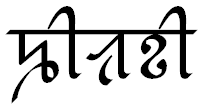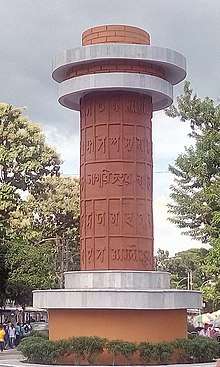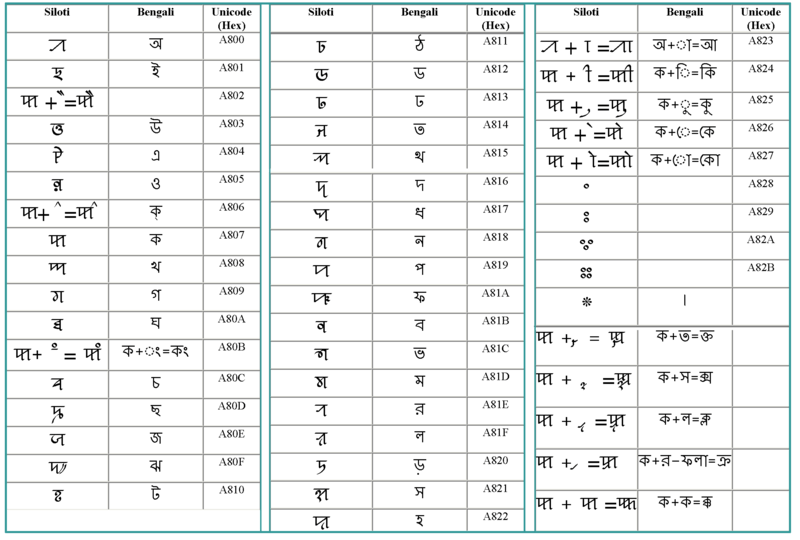Sylheti Nagari
| Sylheti Nagari | |
|---|---|
 The word Silôṭi ('Sylheti') in Sylheti Nagari. | |
| Type | |
| Languages | Sylheti language |
Time period | 1825 CE |
| Direction | Left-to-right |
| ISO 15924 |
Sylo, 316 |
Unicode alias | Syloti Nagri |
| U+A800–U+A82F | |
Sylheti Nagari (Sylheti: ꠍꠤꠟꠐꠤ ꠘꠣꠉꠞꠤ Silôṭi Nagri) is an endangered script used for writing Sylheti. It is closely related to Kaithi, and has some Eastern Nagari influences. Although it has in recent times lost much ground to Bengali, the script is beginning to be reintroduced.[1]
Etymology
The script has also been known as Jalalabad Nagari, Fūl (flower) Nagari,[2] Muslim Nagari, Muhammad Nagari. All of its names are suffixed with Nagari, which implies the script's connection to the Nāgarī script.
Origin

The specific origin of Sylheti Nagari is debated. The general hypothesis is the Muslims of Sylhet were the ones to invent it. Suniti Kumar Chatterji, however, is of the opinion that Shah Jalal brought the script with him when he arrived in the area in the thirteenth or fourteenth century. The bulk of text written in Sylheti Nagari being influenced by Sufism seems to support this hypothesis. On the other hand, according to Ahmad Hasan Dani it was the Afghans living in Sylhet during the Afghan rule who invented the script, since some of Sylheti Nagari's letters resemble the symbols on Afghan coins, and there were a large number of Afghans living in Sylhet at that time. Other less-supported hypotheses are:[3]
- Since the people of Sylhet were familiar with the Devanagari script, they fashioned Sylheti Nagari after it;
- The script was invented by immigrant Bhikkhus from neighboring countries such as Nepal;
- The script could have been invented in the seventeenth—eighteenth century to facilitate the Muslim sepoys coming from the joint state of Bihar and immigrant Muslims;[4]
- A folk belief is that a Muslim invented the script from Bengali writing system for the purpose of mass education[5]
But scholars now validate the three hypotheses: By the followers of Shah Jalal, by Afghans or that the script is indigenous to Sylhet.[3]
Sylheti symbols

Sylheti Nagari is characterized by its simplistic glyph, with fewer letters than Bengali. In addition, Sylheti Nagari didn't have any ligatures.[4] The total number of letters is 32; there are 5 vowels and 28 consonants.
Vowels
The widely accepted number of vowels is 5, although some texts show additional vowels. For example, the diphthong ôi has sometimes been regarded as an additional vowel. It is to be noted that the vowels don't follow the sequence of Bengali alphabet.
| Letter | Diacritic | Transliteration 1 | Transliteration 2 | IPA |
|---|---|---|---|---|
| ꠀ | ꠣ | a | a | /a/ |
| ꠁ | ꠤ | i | i | /i/ |
| ꠃ | ꠥ | u | u | /u/ |
| ꠄ | ꠦ | e | e | /e/, /ɛ/ |
| ꠅ | ꠧ | o | ô | /ɔ/ |
| – | ꠂ | oi | ôi | /ɔi/ |
Consonants
There are 27 consonants.
| Letter | Transliteration 1 | Transliteration 2 | IPA | Note |
|---|---|---|---|---|
| ꠇ | xo | kô | /xɔ/ | Pronounced and transliterated respectively as /k/ and k after and before /i/, /u/ and /k/. |
| ꠈ | xó | khô | /xɔ́/ | Pronounced and transliterated respectively as /k/ and k after and before /i/, /u/ and /k/. (Next vowels can have a rising tone, which is marked with the symbol ́ ) |
| ꠉ | go | gô | /gɔ/ | |
| ꠊ | gó | ghô | /gɔ́/ | |
| ꠌ | so | cô | /sɔ/ | |
| ꠍ | só | chô | /sɔ́/ | |
| ꠎ | zo | jô | /zɔ/ | |
| ꠏ | zó | jhô | /zɔ́/ | |
| ꠐ | ṭo | ṭô | /ʈɔ/ | |
| ꠑ | ṭó | ṭhô | /ʈɔ́/ | |
| ꠒ | ḍo | ḍô | /ɖɔ/ | |
| ꠓ | ḍó | ḍhô | /ɖɔ́/ | |
| ꠔ | to | tô | /t̪ɔ/ | |
| ꠕ | tó | thô | /t̪ɔ́/ | |
| ꠖ | do | dô | /d̪ɔ/ | |
| ꠗ | dó | dhô | /d̪ɔ́/ | |
| ꠘ | no | nô | /nɔ/ | |
| ꠙ | fo | pô | /ɸɔ/ | |
| ꠚ | fó | phô | /fɔ́/ | |
| ꠛ | bo | bô | /bɔ/ | |
| ꠜ | bó | bhô | /bɔ́/ | |
| ꠝ | mo | mô | /mɔ/ | |
| ꠞ | ro | rô | /ɾɔ/ | |
| ꠟ | lo | lô | /lɔ/ | |
| ꠠ | ṛo | ṛô | /ɽɔ/ | |
| ꠡ | sho | shô | /ʃɔ/ | |
| ꠢ | ho | hô | /ɦɔ/ |
Symbols
| Symbol | Transcription | IPA |
|---|---|---|
| ꠆ | – | – |
| ꠋ | ngô | /ŋɔ/ |
| ꠨ | – | – |
| ꠩ | – | – |
| ꠪ | – | – |
| ꠫ | – | – |
Numerals
Sylheti Nagari uses the Bengali-Assamese numerals.
| Sylheti numeral | Hindu-Arabic numeral | Transcription | IPA |
|---|---|---|---|
| ০ | 0 | shuinnô | /ʃuinːɔ/ |
| ১ | 1 | ex | /ex/ |
| ২ | 2 | dui | /d̪ui/ |
| ৩ | 3 | tin | /t̪in/ |
| ৪ | 4 | sair | /saiɾ/ |
| ৫ | 5 | fas | /ɸas/ |
| ৬ | 6 | sôy | /sɔe̯/ |
| ৭ | 7 | hat | /ɦat̪/ |
| ৮ | 8 | aṭ | /aʈ/ |
| ৯ | 9 | nôy | /nɔe̯/ |
| ১০ | 10 | dôsh | /d̪ɔʃ/ |
Spread
As noted before, Sylheti Nagari has been used outside of Sylhet. The script spread to such extents as Calcutta, and Shillong. It has been asserted from scholarly writings that the script was used in Bankura. But from various sources it has been seen that the script was in use in areas apart from the region of Sylhet such as Barisal, Chittagong, Noakhali etc.[3] From the description of Shreepadmanath Debsharma:
| “ | The script in prior times was used in Srihatta. With the advent of printing the script now has spread to all of the Srihatta district, Kachar, Tripura, Noakhali, Chittagong, Mymensingh and to Dhaka, that is, to the Muslims of the entire region of Bengal east of Padma.[6] | ” |
The script is thought to have spread to Chittagong and Barisal via river. Also a large number of immigrants in the United Kingdom from Sylhet have recently introduced the script there.[3]
Usage
Born out of a religious need, Sylheti Nagari has also been used in the daily lives of the inhabitants of Sylhet apart from using in religious literature. Letters, receipts, and even official records has been written using this script. Apart from renowned literary works such as Haltunnobi, Jongonama, Mhobbotnama, Noor Noshihot, Talib Huson etc., it has been used to write medicine and magical manuscripts, as well as Poems of the Second World War. The script, never having been a part of any formal education, reached the common people with seeming ease.[3]
Literature

The simplistic nature of the script inspired a lot of poets, and the bulk of Nagari literature was born. The then Srihatta's Islamia Press, Sarada Press and Calcutta's General Printing Press used to print in Sylheti Nagari. The manuscripts were of prosaic quality,[4] but poetry was also abundant.
Computer font & Android Keyboard
The "New Surma" is a proprietary font. Noto fonts provides an open source font for Sylheti Nagari.
There is an android keyboard on google play store. Syloti Nagri Keyboard is the first android keyboard on Nagri letter. Developed by Sabbir Ahmed and Md Nurul Islam. They are from Metropolitan University, Sylhet.
Sample texts
The following is a sample text in Sylheti, of the Article 1 of the Universal Declaration of Human Rights by the United Nations:
Sylheti in Sylheti Nagari script
- ꠗꠣꠞꠣ ১: ꠢꠇꠟ ꠝꠣꠘꠥꠡ ꠡꠣꠗꠤꠘꠜꠣꠛꠦ ꠢꠝꠣꠘ ꠁꠎ꠆ꠎꠔ ꠀꠞ ꠢꠇ ꠟꠁꠀ ꠙꠄꠖꠣ ‘ꠅꠄ। ꠔꠣꠞꠣꠞ ꠛꠤꠛꠦꠇ ꠀꠞ ꠀꠇꠟ ꠀꠍꠦ। ꠅꠔꠣꠞ ꠟꠣꠉꠤ ꠢꠇꠟꠞ ꠄꠇꠎꠘꠦ ꠀꠞꠇꠎꠘꠞ ꠟꠉꠦ ꠛꠤꠞꠣꠖꠞꠤꠞ ꠝꠘ ꠟꠁꠀ ꠀꠌꠞꠘ ꠇꠞꠣ ꠃꠌꠤꠔ।
Sylheti in phonetic Romanization
- Dara ex: Hôxôl manuš šadinbabe hôman ijjôt ar hôx lôia fôeda ôe. Tarar bibex ar axôl ase. Ôtar lagi hôxlôr exzône arôxzônôr lôge biradôrir môn lôia asôrôn xôra usit.
Sylheti in IPA
- /d̪aɾa ex | ɦɔxɔl manuʃ ʃad̪ínbábe ɦɔman id͡ʒːɔt̪ aɾ ɦɔx lɔia fɔe̯d̪a ɔ́e̯ ‖ t̪aɾaɾ bibex aɾ axɔl asé ‖ ɔt̪aɾ lagi ɦɔxlɔɾ exzɔne arɔxzɔnɔɾ lɔge birad̪ɔɾiɾ mɔn lɔia asɔɾɔn xɔɾa usit̪ ‖/
Gloss
- Clause 1: All human free-manner-in equal dignity and right taken birth-take do. Their reason and intelligence exist; therefore everyone-indeed one another's towards brotherhood-ly attitude taken conduct do should.
Translation
- Article 1: All human beings are born free and equal in dignity and rights. They are endowed with reason and conscience. Therefore, they should act towards one another in a spirit of brotherhood.
Unicode
Sylheti Nagari was added to the Unicode Standard in March, 2005 with the release of version 4.1.
The Unicode block for Sylheti Nagari is U+A800–U+A82F:
| Syloti Nagri[1][2] Official Unicode Consortium code chart (PDF) | ||||||||||||||||
| 0 | 1 | 2 | 3 | 4 | 5 | 6 | 7 | 8 | 9 | A | B | C | D | E | F | |
| U+A80x | ꠀ | ꠁ | ꠂ | ꠃ | ꠄ | ꠅ | ꠆ | ꠇ | ꠈ | ꠉ | ꠊ | ꠋ | ꠌ | ꠍ | ꠎ | ꠏ |
| U+A81x | ꠐ | ꠑ | ꠒ | ꠓ | ꠔ | ꠕ | ꠖ | ꠗ | ꠘ | ꠙ | ꠚ | ꠛ | ꠜ | ꠝ | ꠞ | ꠟ |
| U+A82x | ꠠ | ꠡ | ꠢ | ꠣ | ꠤ | ꠥ | ꠦ | ꠧ | ꠨ | ꠩ | ꠪ | ꠫ | ||||
| Notes | ||||||||||||||||
References
- ↑ "সিলেটি নাগরী", মোহাম্মদ আশরাফুল ইসলাম; বাংলাপিডিয়া, ১০ম খণ্ড; বাংলাদেশ এশিয়াটিক সোসাইটি, ঢাকা। মার্চ ২০০৩ খ্রিস্টাব্দ। পৃষ্ঠা ১৯৭। পরিদর্শনের তারিখ: মে ৬, ২০১১ খ্রিস্টাব্দ।
- ↑ "শ্রীহট্টে নাগরী সাহিত্য (জন্মকথা)", এম. আশরাফ হোসেন সাহিত্যরত্ন; শ্রীহট্ট সাহিত্য-পরিষৎ-পত্রিকা, ১ম বর্ষ ৩য় সংখ্যা; ১৩৪৩ বঙ্গাব্দ; পৃষ্ঠা ৯৮। উদ্ধৃতি: "সহজ ও সুন্দর বলিয়া জনসাধারণ ইহার অপর এক নাম দিয়াছিলেন সিলেটে 'ফুল নাগরী'।"
- 1 2 3 4 5 "সিলেটি নাগরী:ফকিরি ধারার ফসল", মোহাম্মদ সাদিক; বাংলাদেশ এশিয়াটিক সোসাইটি, ঢাকা; ডিসেম্বর ২০০৮; ISBN 984-300-003029-0। পরিদর্শনের তারিখ: ৫ মে ২০১১ খ্রিস্টাব্দ।
- 1 2 3 "হজরত শাহ্ জালাল ও সিলেটের ইতিহাস", সৈয়দ মুর্তাজা আলী; উৎস প্রকাশন, ঢাকা; জুলাই ২০০৩; ISBN 984-889-000-9; পৃষ্ঠা ১৪৮ (২০০)। পরিদর্শনের তারিখ: ০৬ মে ২০১১ খ্রিস্টাব্দ।
- ↑ "শ্রীহট্ট-নাগরী লিপির উৎপত্তি ও বিকাশ", আহমদ হাসান দানী; বাঙলা একাডেমী পত্রিকা, প্রথম বর্ষ, দ্বিতীয় সংখ্যা, ভাদ্র-অগ্রহায়ণ, ১৩৬৪ বঙ্গাব্দ; পৃষ্ঠা ১।
- ↑ "সিলেট নাগরী", শ্রী পদ্মনাথ দেবশর্ম্মা; সাহিত্য-পরিষৎ-পত্রিকা, ৪র্থ সংখ্যা; ১৩১৫ বঙ্গাব্দ, পৃষ্ঠা ২৩৬।
